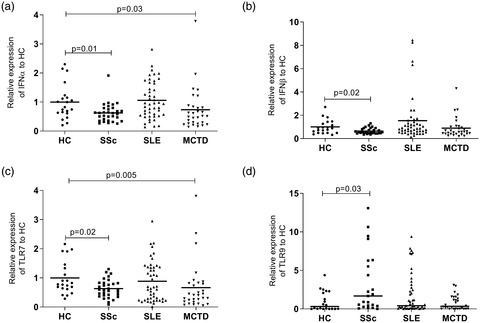当前位置:
X-MOL 学术
›
Clin. Exp. Immunol.
›
论文详情
Our official English website, www.x-mol.net, welcomes your
feedback! (Note: you will need to create a separate account there.)
Variety of endosomal TLRs and Interferons (IFN‐α, IFN‐β, IFN‐γ) expression profiles in patients with SLE, SSc and MCTD
Clinical & Experimental Immunology ( IF 3.4 ) Pub Date : 2020-12-17 , DOI: 10.1111/cei.13566 A Paradowska-Gorycka 1 , A Wajda 1 , B Stypinska 1 , E Walczuk 1 , E Rzeszotarska 1 , M Walczyk 2 , E Haladyj 3 , K Romanowska-Prochnicka 2, 4 , A Felis-Giemza 2 , A Lewandowska 2 , M Olesińska 2
Clinical & Experimental Immunology ( IF 3.4 ) Pub Date : 2020-12-17 , DOI: 10.1111/cei.13566 A Paradowska-Gorycka 1 , A Wajda 1 , B Stypinska 1 , E Walczuk 1 , E Rzeszotarska 1 , M Walczyk 2 , E Haladyj 3 , K Romanowska-Prochnicka 2, 4 , A Felis-Giemza 2 , A Lewandowska 2 , M Olesińska 2
Affiliation

|
We investigated Toll‐like receptor (TLR)‐3/‐7/‐8/‐9 and interferon (IFN)‐α/β/γ mRNA expression in whole blood and serum IFN‐α/β/γ levels in patients with mixed connective tissue disease (MCTD), systemic lupus erythematosus (SLE) and systemic sclerosis (SSc) and in healthy subjects to assess the association between the TLR–IFN expression and severity of and susceptibility to diseases, and identify potential biomarkers. Expression of the IFN‐γ, TLR‐3 and TLR‐8 was detected only in SLE patients. TLR‐7, IFN‐α and IFN‐β expression was highest in SLE, while TLR‐9 expression was highest in SSc patients. In SLE and MCTD patients a strong correlation was observed between TLR‐7 and IFN‐α expression and IFN‐β and IFN‐α expression. In MCTD patients, negative correlation between IFN‐α and TLR‐9 and TLR‐7 and TLR‐9 was revealed. TLR‐9 expression in anti‐U1‐70k‐negative, anti‐C negative and anti‐SmB‐negative MCTD patients was higher than in MCTD‐positive patients. We observed negative correlations between serum IFN‐α levels and TLR‐7 expression and C3 and C4 levels in SLE patients. In SLE patients we observed that with increased IFN‐γ, TLR‐3 and TLR‐8 expression increased the value of C3 and C4. Our results confirmed that the endosomal TLR–IFN pathway seems to be more important in SLE than in MCTD or SSc, and that IFN‐α and IFN‐β may be possible biomarkers for SLE.
中文翻译:

SLE、SSc 和 MCTD 患者的各种内体 TLR 和干扰素(IFN-α、IFN-β、IFN-γ)表达谱
我们调查了混合型患者全血中 Toll 样受体 (TLR)-3/-7/-8/-9 和干扰素 (IFN)-α/β/γ mRNA 表达和血清 IFN-α/β/γ 水平结缔组织病 (MCTD)、系统性红斑狼疮 (SLE) 和系统性硬化症 (SSc) 以及在健康受试者中评估 TLR-IFN 表达与疾病严重程度和易感性之间的关联,并确定潜在的生物标志物。仅在 SLE 患者中检测到 IFN-γ、TLR-3 和 TLR-8 的表达。SLE 患者 TLR-7、IFN-α 和 IFN-β 表达最高,而 SSc 患者 TLR-9 表达最高。在 SLE 和 MCTD 患者中,观察到 TLR-7 和 IFN-α 表达与 IFN-β 和 IFN-α 表达之间有很强的相关性。在 MCTD 患者中,发现 IFN-α 与 TLR-9 和 TLR-7 与 TLR-9 呈负相关。抗 U1-70k 阴性、抗 C 阴性和抗 SmB 阴性 MCTD 患者的 TLR-9 表达高于 MCTD 阳性患者。我们观察到 SLE 患者血清 IFN-α 水平与 TLR-7 表达和 C3 和 C4 水平呈负相关。在 SLE 患者中,我们观察到随着 IFN-γ、TLR-3 和 TLR-8 表达的增加,C3 和 C4 的值增加。我们的结果证实,内体 TLR-IFN 通路在 SLE 中似乎比在 MCTD 或 SSc 中更重要,并且 IFN-α 和 IFN-β 可能是 SLE 的可能生物标志物。TLR-3 和 TLR-8 表达增加了 C3 和 C4 的值。我们的结果证实,内体 TLR-IFN 通路在 SLE 中似乎比在 MCTD 或 SSc 中更重要,并且 IFN-α 和 IFN-β 可能是 SLE 的可能生物标志物。TLR-3 和 TLR-8 表达增加了 C3 和 C4 的值。我们的结果证实,内体 TLR-IFN 通路在 SLE 中似乎比在 MCTD 或 SSc 中更重要,并且 IFN-α 和 IFN-β 可能是 SLE 的可能生物标志物。
更新日期:2020-12-17
中文翻译:

SLE、SSc 和 MCTD 患者的各种内体 TLR 和干扰素(IFN-α、IFN-β、IFN-γ)表达谱
我们调查了混合型患者全血中 Toll 样受体 (TLR)-3/-7/-8/-9 和干扰素 (IFN)-α/β/γ mRNA 表达和血清 IFN-α/β/γ 水平结缔组织病 (MCTD)、系统性红斑狼疮 (SLE) 和系统性硬化症 (SSc) 以及在健康受试者中评估 TLR-IFN 表达与疾病严重程度和易感性之间的关联,并确定潜在的生物标志物。仅在 SLE 患者中检测到 IFN-γ、TLR-3 和 TLR-8 的表达。SLE 患者 TLR-7、IFN-α 和 IFN-β 表达最高,而 SSc 患者 TLR-9 表达最高。在 SLE 和 MCTD 患者中,观察到 TLR-7 和 IFN-α 表达与 IFN-β 和 IFN-α 表达之间有很强的相关性。在 MCTD 患者中,发现 IFN-α 与 TLR-9 和 TLR-7 与 TLR-9 呈负相关。抗 U1-70k 阴性、抗 C 阴性和抗 SmB 阴性 MCTD 患者的 TLR-9 表达高于 MCTD 阳性患者。我们观察到 SLE 患者血清 IFN-α 水平与 TLR-7 表达和 C3 和 C4 水平呈负相关。在 SLE 患者中,我们观察到随着 IFN-γ、TLR-3 和 TLR-8 表达的增加,C3 和 C4 的值增加。我们的结果证实,内体 TLR-IFN 通路在 SLE 中似乎比在 MCTD 或 SSc 中更重要,并且 IFN-α 和 IFN-β 可能是 SLE 的可能生物标志物。TLR-3 和 TLR-8 表达增加了 C3 和 C4 的值。我们的结果证实,内体 TLR-IFN 通路在 SLE 中似乎比在 MCTD 或 SSc 中更重要,并且 IFN-α 和 IFN-β 可能是 SLE 的可能生物标志物。TLR-3 和 TLR-8 表达增加了 C3 和 C4 的值。我们的结果证实,内体 TLR-IFN 通路在 SLE 中似乎比在 MCTD 或 SSc 中更重要,并且 IFN-α 和 IFN-β 可能是 SLE 的可能生物标志物。











































 京公网安备 11010802027423号
京公网安备 11010802027423号